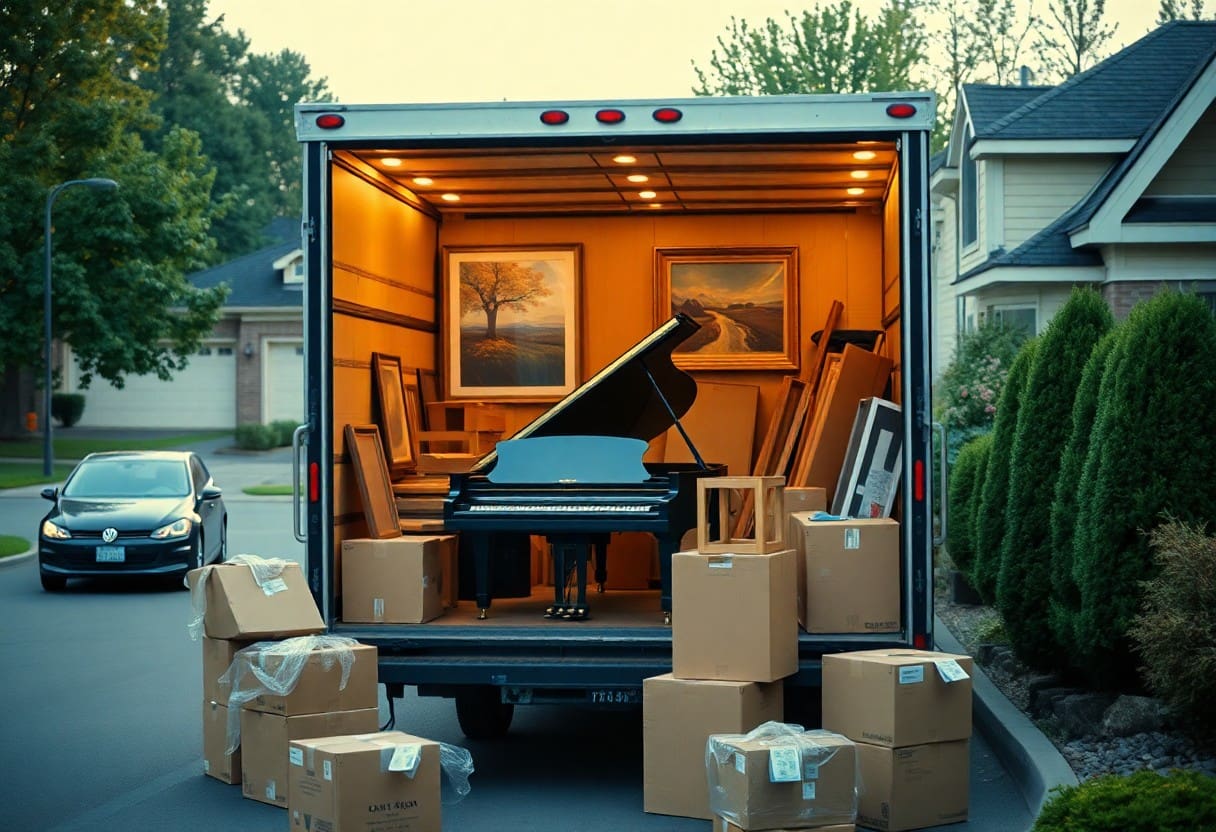Specialty items require extra attention during a long distance move to ensure they arrive at your new home in perfect condition. You may own fragile art, delicate antiques, or valuable musical instruments that need specific packing and handling techniques. In this guide, you will learn crucial tips for safeguarding your unique possessions, so you can have peace of mind throughout the moving process. By following these strategies, you’ll be well-prepared to transport your specialty items with confidence and care.
Assessing Your Specialty Items
The first step in handling specialty items during your long distance move is assessing what you have. Make a detailed inventory of all your unique and high-value possessions, including antiques, art, and electronics. Understanding the type and quantity of these items will help you determine the best packing methods, as well as any special services you may need from moving companies.
Identifying Fragile and High-Value Items
Along with your inventory, take the time to identify any fragile and high-value items. Look for pieces made of glass, ceramic, or delicate materials that may require extra care during packing and transport. Prioritizing these items will ensure that they are adequately protected throughout the moving process.
Understanding Special Requirements for Certain Items
One of the most important aspects of preparing specialty items for your long distance move is understanding any special requirements that may apply. Some items, like pianos, valuable artwork, or fish tanks, might need specialized packing or handling procedures to prevent damage.
This careful attention to detail means researching the specific needs of your specialty items. For instance, fine art may require climate control during transport, while pianos need expertise in disassembly and reassembly. It’s also important to check if your items are covered under your moving company’s insurance policy and what documentation you may need to provide to ensure their safe arrival at your new home.
Proper Packing Techniques
Assuming you want to ensure the safety of your specialty items during your long-distance move, it’s important to adopt effective packing techniques. Specialty items often include fragile, valuable, or unusual objects that require extra attention. By using the right methods and ensuring proper packing materials, you can minimize the risk of damage during transit.
Materials Needed for Protection
Among the materials you should gather include high-quality packing paper, bubble wrap, and sturdy boxes. Additionally, consider using foam corners, packing peanuts, and tape for securing your items. Having the right materials on hand will give your specialty items the best chance of arriving safely at your new destination.
Step-by-Step Packing Guide
Packing your specialty items properly is crucial for their protection. Follow this step-by-step guide to pack effectively:
| Step | Action |
|---|---|
| 1 | Gather all necessary materials and boxes. |
| 2 | Wrap each item thoroughly in packing paper or bubble wrap. |
| 3 | Fill boxes with packing peanuts or crumpled paper for cushioning. |
| 4 | Close and securely tape the boxes, labeling them accordingly. |
Hence, following this structured approach ensures your specialty items are packed securely and efficiently. By taking the time to wrap and cushion each piece, you will significantly reduce the potential for damage. Always make sure to label the boxes clearly, as this will help you when unloading. Proper organization and attention to detail can make all the difference in safeguarding your valuable belongings during your long-distance move.
Choosing the Right Moving Company
Even when you’re managing a long-distance move, selecting the right moving company can significantly ease the process of handling specialty items. A reliable mover understands the unique challenges these items present and will have the expertise and resources to transport them safely. By obtaining quotes and comparing services, you can identify the company that best aligns with your needs, ensuring a smoother transition to your new location.
Researching Specialty Item Movers
Before you finalize any decisions, it’s important to research moving companies that specialize in your type of specialty items. Look for movers with experience handling antiques, pianos, or fragile collectibles, as they often have specific protocols to ensure your valuables are protected during transit. Online reviews and testimonials can provide insights into other clients’ experiences, helping you assess each company’s reliability and professionalism.
Asking the Right Questions
Below are some key questions to ask potential movers about their experience and procedures for handling specialty items.
Right questions can help you gauge a moving company’s competency in managing specialty items. Inquire about their specific experience with the items you need to move, what protective measures they use, and how they handle any potential damage during transit. Additionally, ask for insurance coverage details and whether they offer any guarantees. This information will help you make an informed decision, ensuring that your prized possessions are in safe hands throughout the moving process.
Insurance Options for Specialty Items
Keep in mind the importance of insuring your specialty items during a long-distance move. Securing the right insurance options can protect your valuable items from damage or loss. You’ll want to explore various coverage options that meet your specific needs and give you peace of mind throughout the journey.
Types of Coverage Available
Keep exploring the options available to you for insuring your specialty items. Here are some types of coverage you might consider:
- Full Value Protection
- Declared Value Protection
- Actual Cash Value
- Separate Renter’s Insurance
Perceiving the right type of coverage will help you safeguard your specialty items effectively.
| Coverage Type | Description |
| Full Value Protection | Covers the full value of items in case of loss or damage. |
| Declared Value Protection | Reimburses based on the specified value you declare. |
| Actual Cash Value | Reimburses current market value minus depreciation. |
| Separate Renter’s Insurance | Provides coverage for items even when being moved. |
Importance of Inventory Documentation
Along with securing insurance, maintaining an accurate inventory is imperative for your long-distance move. Documenting your specialty items ensures that you have a detailed list in case of potential claims or disputes with the moving company.
Due to the unique nature of specialty items, having a thorough inventory allows you to track each item’s condition before, during, and after the move. This documentation can be invaluable when asserting a claim for damaged or missing items, providing strong evidence for your insurance provider. By taking the time to zip through your belongings and photograph them, you can significantly ease the stress associated with long-distance moving.
Special Considerations for Specific Items
Unlike standard household goods, specialty items require unique handling and packing techniques to ensure they arrive at your new home intact. Understanding how to manage these prized possessions will help you avoid potential damage and financial loss during your long-distance move.
Art and Antiques
On moving day, your valuable art pieces and antiques demand extra attention. Use appropriate packing materials like bubble wrap and custom crates to protect their delicate surfaces and avoid scratches or breaks. Professional movers with experience in handling artworks may be a worthwhile investment for peace of mind.
Musical Instruments
With musical instruments, you need to take specific precautions to maintain their integrity during transit. Ensure that you pack them in their original cases or high-quality protection designed for their type, and pay attention to climate conditions that might affect your instrument’s quality.
Indeed, the quality and condition of your musical instruments can be affected by temperature and humidity changes. Make sure to keep your instruments in a climate-controlled vehicle when moving, and consider adding moisture-absorbing packs within the case. If you’re moving long distances, let professionals handle any larger instruments, like pianos, as they come with added complexity that requires specialized knowledge and equipment.
Tips for Unpacking Specialty Items
For a smooth unpacking experience, follow these tips for your specialty items:
- Inspect items for damage before unpacking.
- Organize packing materials for safe disposal.
- Utilize the original packaging when possible.
- Unpack one item at a time to stay organized.
- Take your time and avoid rushing the process.
Recognizing the specific care your specialty items need will make the process easier and safer.
Safe Unpacking Procedures
Across your unpacking journey, prioritize safety by wearing protective gear, such as gloves and sturdy footwear, when handling fragile items. Ensure you have a stable surface to work on, and avoid lifting heavy pieces alone to prevent injury. Consider using tools like dollies or moving straps to manage bulkier items effectively.
Setting Up in Your New Space
Any time you find yourself arranging specialty items in your new home, take a moment to assess their best placement. Consider factors such as functionality, accessibility, and aesthetics.
Understanding how to create an effective layout for your specialty items can enhance your new space’s flow and usability. Take measurements before moving large furniture and consider your daily routines. Strategically placing items where you use them most can improve convenience while showcasing their unique features. Don’t hesitate to rearrange as needed for optimal organization and appeal.
To wrap up
On the whole, handling specialty items during your long distance move requires careful planning and attention to detail. You should take the time to assess each item’s unique needs, whether it’s fragile artwork, electronics, or oversized furniture. Proper packing materials and methods are necessary, as is selecting a reliable moving company experienced with specialty items. By organizing your belongings, labeling boxes clearly, and communicating any specific requirements to your movers, you can ensure that your valuable items arrive safely and intact at your new home.

